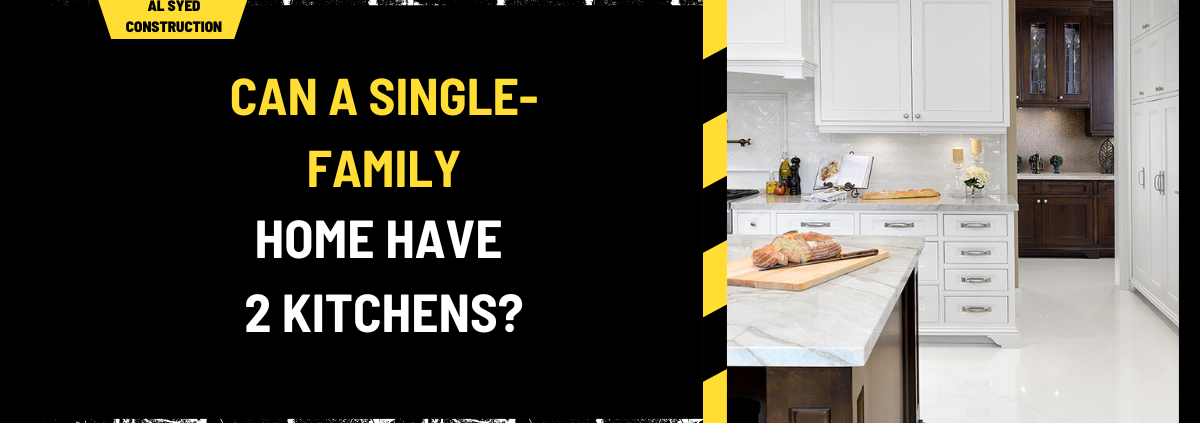Can a Single-Family Home Have 2 Kitchens?
When considering modifications or purchases of a single-family home, one common question arises: Can a single-family home have two kitchens? This inquiry is particularly relevant for those contemplating renovations, multi-generational living arrangements, or simply seeking to understand the flexibility of their home’s layout. This comprehensive guide explores the possibilities, challenges, and regulations surrounding the inclusion of two kitchens in a single-family home.
Table of Contents
Understanding the Basics: What Constitutes a Kitchen?
To determine if a single-family home can have two kitchens, it’s essential first to define what constitutes a kitchen. Typically, a kitchen includes:
- Cooking Facilities: This generally means a stove, oven, and possibly a microwave.
- Food Storage: Includes a refrigerator and possibly a pantry or cabinets.
- Sink: For food preparation and cleaning.
- Counter Space: Essential for meal preparation.
When a home includes these elements in two separate areas, each space can be considered a kitchen.
Legal and Zoning Considerations
**1. Local Zoning Laws and Regulations
The feasibility of installing a second kitchen in a single-family home often depends on local zoning laws and building codes. Many municipalities have regulations that dictate how many kitchens a single-family residence can have. These rules are designed to maintain the character of residential neighborhoods and ensure that homes are used according to their intended purposes.
Zoning regulations might include:
- Permitted Use: Some areas restrict the use of a single-family home for multi-family purposes, which could impact the allowance of a second kitchen.
- Building Codes: Codes may require that kitchens meet specific safety and health standards, which could influence the installation of a second kitchen.
**2. Homeowner Association (HOA) Rules
For properties within a Homeowner Association (HOA) jurisdiction, additional rules and regulations may apply. HOAs can impose restrictions on modifications to a property, including the addition of a second kitchen. It is crucial to consult the HOA’s guidelines and obtain the necessary approvals before proceeding.
Practical Considerations for Adding a Second Kitchen
**1. Space and Layout
Adding a second kitchen involves careful planning regarding space and layout. Considerations include:
- Location: The second kitchen should be strategically placed to maximize functionality and minimize disruption to the home’s flow.
- Ventilation: Proper ventilation is essential to prevent odors and ensure a healthy environment. Installing an additional range hood or ventilation system may be necessary.
**2. Utilities and Infrastructure
A second kitchen requires additional utilities, including:
- Plumbing: Ensuring adequate plumbing for a sink and possibly a dishwasher.
- Electrical Wiring: Upgrading electrical systems to handle the additional load from appliances.
- Gas Lines: If using a gas stove, appropriate gas lines must be installed.
**3. Cost Implications
The cost of installing a second kitchen can vary significantly based on factors such as:
- Size and Scope of Renovation: Larger or more complex installations will incur higher costs.
- Materials and Appliances: The quality and brand of materials and appliances will affect the overall budget.
- Labor Costs: Professional installation and renovation services can be a significant part of the expense.
Benefits of Having Two Kitchens
**1. Multi-Generational Living
A second kitchen can be highly beneficial for multi-generational living arrangements. Families that accommodate grandparents or adult children may find having separate kitchen spaces to be practical and convenient.
**2. Increased Property Value
In some cases, having two kitchens can potentially increase the property value. This feature might appeal to future buyers who are interested in multi-generational living or rental opportunities.
**3. Enhanced Convenience
A second kitchen provides additional convenience for large families or those who frequently entertain guests. It allows for more efficient meal preparation and organization.
Potential Drawbacks of Two Kitchens
**1. Reduced Living Space
Adding a second kitchen might reduce the overall living space within the home, potentially making other areas feel cramped. It’s important to balance the benefits of additional kitchen space with the impact on the home’s overall layout.
**2. Increased Maintenance
With two kitchens, maintenance tasks are doubled. This includes cleaning, repairs, and upkeep of appliances, which can increase the time and effort required for home management.
**3. Compliance and Approval
Securing the necessary approvals and compliance with local regulations can be challenging and time-consuming. Ensuring that all modifications meet legal standards is crucial to avoid future issues.
Conclusion
A single-family home can indeed have two kitchens, but this decision involves careful consideration of legal, practical, and financial factors. Understanding local zoning laws, consulting with homeowners associations, and planning for space and utility requirements are all essential steps in the process. By addressing these factors, homeowners can effectively integrate a second kitchen into their property, enhancing functionality and convenience.




